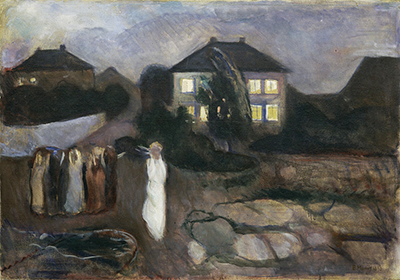The Storm by Edvard Munch was painted in oil on canvas in 1893 and depicts a seaside scene in the small Norwegian town of Asgardstrand, where Munch would often stay.
The painting is intensely atmospheric and viewers can tangibly feel the howling force of the storm, with the central figure dressed in white and closing their ears to the sound of the wailing winds. The Storm by Edvard Munch also depicts a further group standing huddled together on the shore, with two houses in the background, their windows adding illumination to the otherwise dark and moody background. The trees are bent over with the force of the wind and the background is swirling and imperceivable, a cacophony of blues, purples, pinks and yellows to perfectly illustrate the tumultuous stormy skies.
The central figure in white however is very important when considering the works of Edvard Munch, as his arguably most famous work The Scream was painted shortly afterwards and shows a similar central figure holding their hands to their ears to block out the terror of the world around them. Edvard Munch is famous for the Symbolism in his paintings, however The Storm has a more naturalistic feel, with the background, people in the foreground and the houses all blending into one impervious landscape. The characters painted are thought to be all female, and the painting again highlight Munch's preoccupation with the theme of togetherness and apart. Here, The Storm shows a huddled group who are standing together for protecting from the elements which contrasts starkly with a lone figure who is standing further towards the shore and is facing the storm head on, alone and solitary.
The Storm depicts scene of natures brutality, however the colours and paintbrush strokes are soft and blend together. This swirling and blending style of colours and outlines give a feeling of not just the turbulence of nature, but also of inner conflict too, with the solitary woman looking almost ghostlike against the crowd of darker clothed women. Some critics have also cited the woman in white as clearly virginal, making her way from her wedding party feast in the illuminated house in the background, down towards the churning sea, and onwards towards the wide and unstoppable forces of nature, which are closely aligned in art to sexual exploration. Munch often painted women in various life stages, and it is possible The Strom again explores this theme of the virgin's awakening.




